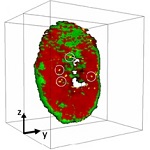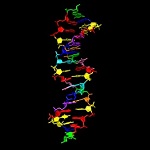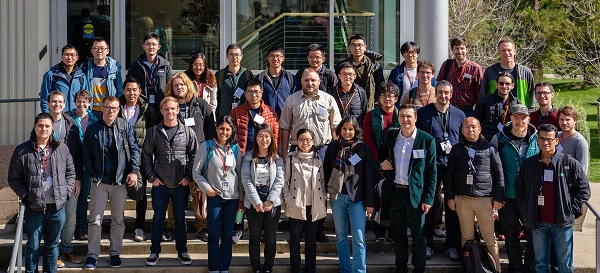Vol. 19, No. 7 - March 2019
View the Archives

From the Science DirectorAs we announced in the January 2019 issue of SSRL Headline News, Kelly Gaffney steps down as SSRL Director on March 31, 2019 to become the Chemical Sciences Division Director at SLAC (a role he actually assumed on February 1). Piero Pianetta is stepping in as SSRL Director through June 30, at which point the baton is handed to Paul McIntyre. SSRL Management wants to express our sincere appreciation and thanks to Kelly for his leadership, wishing him success in his new responsibilities, and looks forward to interacting with him as a scientific collaborator and SSRL user in the future. Science Highlights
Ni-rich Layered Cathode Particle’s Response to Aggressive Charging at High Voltage Revealed by Machine Learning – Contacts: Yijin Liu (SSRL) and Enyuan Hu (BNL) The expanded use of renewable energies instead of fossil fuels depends on developing better batteries. Researchers are finding ways to make batteries store more energy, have more efficient output, and last longer at lower cost. In order to properly function in applications that demand high energy and power density, like electric automobiles, the loss of storage capacity in lithium ion batteries during high-voltage charging and discharging cycles needs to be mitigated. Scientists from SSRL and BNL studied nickel-rich layered materials (NMC) used as cathodes in high energy density lithium-ion batteries to understand why they lose capacity during high-voltage cycling. Read more... See also: Brookhaven Newsroom: Cause of Cathode Degradation Identified for Nickel-rich Materials
Doubling the DNA Alphabet: Implications for Life in the Universe and DNA Storage – Contacts: Steven Benner (Foundation for Applied Molecular Evolution) and Millie Georgiadis (Indiana University School of Medicine) Our genetic information is stored in DNA using just four nucleotide bases: A, C, G, and T. While we may never understand how these particular molecular combinations came to store the instructions for all life on Earth, we can address some questions about their role, such as: are these the only four bases that could create a DNA double helix with the right balance of stability and flexibility for cells to store and access genetic information? A team of scientists answered this question by introducing four new, synthetic bases into DNA, forming “hachimoji DNA,” named using the Japanese words for eight letters. Read more... New Video Releases3D Printing for Perfect Metal Parts March 26, 2019 SLAC Public Lecture by Chris Tassone 3-D printing is a fundamentally new way of manufacturing things, building them up layer by layer rather than by carving or molding materials. This can allow us to create exceptionally complex metal parts on demand, make faster, lighter vehicles, prototype new technologies and even build habitats on distant planets. But to make it work, the structure of the printed metal has to be reliably strong and uniform at the microscopic and even the atomic scale. Achieving this high level of precision and control will require a solid understanding of exactly what is happening to the microstructure of a printed part as it is being created. In this SLAC Public Lecture, Chris Tassone talks about tools for looking beneath the surface of metal additive manufacturing, understanding the physics involved and controlling the physics to create metal components of the future. See video Making Science Happen “Making Science Happen” tells a story about the bold people behind the science at SLAC. It gives the outside world a glimpse into the inner world of our lab: the expertise, creativity and enthusiasm that enables us to do great things together. See video Meeting SummaryWorkshop on Resonant Inelastic X-ray Scattering with Hard X-rays February 20-22, 2019 The hard x-ray spectroscopy group at SSRL organized a summer school on hard x-ray resonant inelastic x-ray scattering (RIXS) from February 20-22, 2019. This workshop on the fundamental aspects of hard x-ray RIXS included lectures and tutorials from basic to more advanced levels. Hard x-ray RIXS is a powerful spectroscopic tool due to the two-dimensional data planes, the high resolution in the energy transfer direction and the large penetration depth of the x-rays. SSRL-Related NewsThe Children’s Museum of Indianapolis announced plans this week for Mission Jurassic, a project that will support paleontological excavation of a fossil-rich plot of land in northern Wyoming. The project will bring together scientists from around the world, including SLAC, SSRL and the University of Manchester, to reveal dramatic new secrets about the world of millions of years ago. Read more... EventsTime- and Space-Resolved X-ray Absorption Spectroscopy (XAS) at SSRL: Analysis of Large Data Sets, June 3-4, 2019 Save the dates, June 3-4, to participate in this short course sponsored by Co-ACCESS at SSRL. As SSRL transitions from step-scanning XAS to continuous and quick scanning (QEXAFS), time resolution will improve from 10 minutes per spectrum to below 1 second, meaning that the number of spectra that will need to be analyzed will increase dramatically. A similar situation already exists with space-resolved data in x-ray microscopy where thousands and sometimes even millions of spectra need to be processed. With these new parameters, we need appropriate software to process these data batches and extract time- and space-resolved chemical information. This course will present examples of large XAS data sets and solutions for their batch processing, including hands-on exercises. The future in correlated data collection and analysis will also be discussed. A website with registration details will be announced shortly. Stanford-SLAC Cryo-EM Center (S2C2) Workshop Series website U.S. Particle Accelerator School June 17-28, 2019 website Joint SSRL/LCLS Users’ Conference September 25-27, 2019 EMSL Integration 2019 – Plants, Soil and Aerosols: Interactions that tell stories of Ecosystems, Climate and National Security” October 8-10, 2019 announcement User Research AdministrationBeam Time Requests
The schedule and beam time assignments for most SSRL X-ray/VUV beam lines through July 29, 2019 is now available through the user portal. Log into the user portal to view/accept beam time assignments or to submit beam time requests for eligible proposals. Users who have already reached the number of shifts estimated in their original proposal or who want to propose new experiments should consider submitting new proposals by the posted deadlines. Proposal Deadlines SSRL
See SSRL Proposal & Scheduling Guidelines Cryo-EM
Submit proposals through the User Portal. _____________________________________________________________________ The Stanford Synchrotron Radiation Lightsource (SSRL) is a third-generation light source producing extremely bright x-rays for basic and applied research. SSRL attracts and supports scientists from around the world who use its state-of-the-art capabilities to make discoveries that benefit society. SSRL, a U.S. DOE Office of Science national user facility, is a Directorate of SLAC National Accelerator Laboratory, operated by Stanford University for the U.S. Department of Energy Office of Science. The SSRL Structural Molecular Biology Program is supported by the DOE Office of Biological and Environmental Research, and by the National Institutes of Health, National Institute of General Medical Sciences. For more information about SSRL science, operations and schedules, visit http://www-ssrl.slac.stanford.edu. To unsubscribe from SSRL Headlines, just send an e-mail to listserv@slac.stanford.edu with "signoff ssrl-headlines" in the body. To subscribe, send an e-mail to listserv@slac.stanford.edu with "subscribe ssrl-headlines" in the body. Questions? Comments? Contact Lisa Dunn
|



